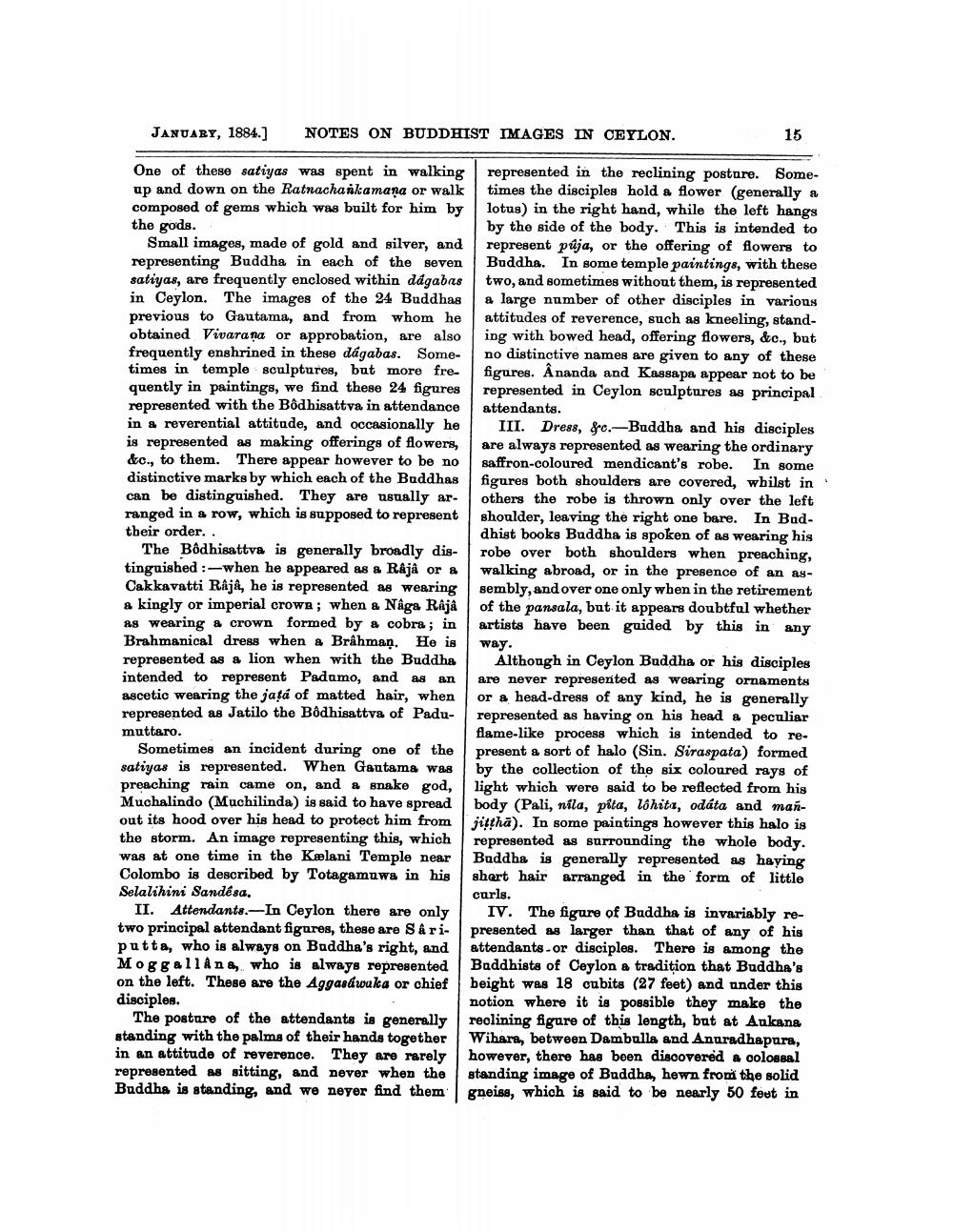________________
JANUARY, 1884.]
NOTES ON BUDDHIST IMAGES IN CEYLON.
15
One of these satiyas was spent in walking represented in the reclining postore. Someup and down on the Ratnachankamana or walk times the disciples hold a flower (generally a composed of gems which was built for him by lotus) in the right hand, while the left hangs the gods.
by the side of the body. This is intended to Small images, made of gold and silver, and represent púja, or the offering of flowers to representing Buddha in each of the seven Buddha. In some temple paintings, with these satiyas, are frequently enclosed within dagabas two, and sometimes without them, is represented in Ceylon. The images of the 24 Buddhas a large number of other disciples in various previous to Gautama, and from whom he attitudes of reverence, such as kneeling, standobtained Vivarana or approbation, are also ing with bowed head, offering flowers, &c., but frequently enshrined in these dágabas. Some- no distinctive names are given to any of these times in temple sculptures, but more fre- figures. Ananda and Kassapa appear not to be quently in paintings, we find these 24 figures represented in Ceylon sculptures as principal represented with the Bôdhisattva in attendance attendants. in a reverential attitude, and occasionally he III. Dress, fc.-Buddha and his disciples is represented as making offerings of flowers, are always represented as wearing the ordinary &c., to them. There appear however to be no saffron-coloured mendicant's robe. In some distinctive marks by which each of the Buddhas figures both shoulders are covered, whilst in can be distinguished. They are usually ar- others the robe is thrown only over the left ranged in a row, which is supposed to represent shoulder, leaving the right one bare. In Badtheir order..
dhist books Buddha is spoken of as wearing his The Bôdhisattva is generally broadly dis- robe over both shoulders when preaching, tinguished :-when he appeared as a Râjâ or a walking abroad, or in the presence of an asCakkavatti Râjâ, he is represented as wearing sembly, and over one only when in the retirement a kingly or imperial crowa; when a Naga Raja of the pansala, but it appears doubtful whether as wearing & crown formed by a cobra; in artists have been guided by this in any Brahmanical dress when a Brâhman. He is way. represented as a lion when with the Buddha Althongh in Ceylon Buddha or his disciples intended to represent Padamo, and as an are never represented as wearing ornaments ascetic wearing the jatá of matted hair, when or a head-dress of any kind, he is generally represented as Jatilo the Bôdhisattva of Padu- represented as having on his head a peculiar muttaro.
flame-like process which is intended to reSometimes an incident during one of the present a sort of halo (Sin. Siraspata) formed satiyas is represented. When Gautama was by the collection of the six coloured rays of preaching rain came on, and a snake god, light which were said to be reflected from his Muchalindo (Muchilinda) is said to have spread body (Pali, nila, pita, lóhiti, odáta and manout its hood over his head to protect him from jitthā). In some paintings however this halo is the storm. An image representing this, which represented as surrounding the whole body. was at one time in the Kælani Temple near Buddha is generally represented as haying Colombo is described by Totagamuwa in his short hair arranged in the form of little Selalihini Sandésa.
curls. II. Attendants.-In Ceylon there are only IV. The figure of Buddha is invariably retwo principal attendant figures, these are Sari- presented as larger than that of any of his putta, who is always on Buddha's right, and attendants or disciples. There is among the MoggallAna, who is always represented Buddhists of Ceylon a tradition that Buddha's on the left. These are the Aggastwuka or chief beight was 18 cubits (27 feet) and under this disciples.
notion where it is possible they make the The posture of the attendants is generally reclining figure of this length, but at Aukana standing with the palms of their hands together Wihara, between Dambulla and Anuradhapura, in an attitude of reverence. They are rarely however, there has been discovered a colossal represented as sitting, and never when the standing image of Buddha, hewn from the solid Buddha is standing, and we never find them gneiss, which is said to be nearly 50 feut in




